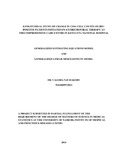| dc.contributor.author | Makory, Valeria N | |
| dc.date.accessioned | 2014-12-10T12:24:14Z | |
| dc.date.available | 2014-12-10T12:24:14Z | |
| dc.date.issued | 2014 | |
| dc.identifier.citation | Masters of science in medical statistics at the university of Nairobi, Institute of Tropical and Infectious Diseases (UNITID) | en_US |
| dc.identifier.uri | http://hdl.handle.net/11295/77105 | |
| dc.description.abstract | Background: The measurement of CD4+ T-cell (CD4) counts is a strong predictor of progression to AIDS and a means of monitoring antiviral therapy (ART). Understanding the wayCD4+ cell counts change over time would provide insight into the way patients respond to treatment and how effective treatment is with time. Secondary data from the Comprehensive Care Centre at KNH was utilized in which patients were enrolled and their CD4+ cell counts were regularly monitored thus generating repeated measures of their CD4+ cell counts. The aim of the present study was to assess the parsimony of the Generalized Estimating Equations and Generalized Linear Mixed effects models in assessing the change in the CD4+ count in HIV-positive patients initiated on ART over a period of at least five years.
Methodology :A Retrospective Longitudinal study with data obtained from the CCC at KNH, Nairobi of HIV-Positive patients enrolled and their CD4+ cell counts initially taken on enrolment into the ART programs and thereafter counted every 12 weeks. The study subjects were enrolled in the CCC between the period of 2008 and 2012 and all were over 18 years at the time of enrolment into the ART program. A total of 248 patients formed the sample and were used in the study. Data was explored using basic descriptive statistics and a profile of the mean CD4+ cell count over the period of the study done. GLMM and GEE models were used to model the change in CD4+ cell count over time. GLMM took into account both within and between sources of variation was flexible enough to account for the natural heterogeneity in the population and handle the degree of missing data while GEE allowed for the correlation between observations.
Results :The analysis included 248 individuals. The mean CD4+ cell count was seen to increase with duration of treatment on ART. The patient‘s age, ART regimen and WHO clinical staging did not affect the current CD4+ cell count status. However, BMI and CD4+ cell counts after 12 weeks on treatment were significant predictors on the current CD4+ cell count. GEE model was the most parsimonious model compared to GLMM as proven by the lower Standard Error and also the AIC, Likelihood ration and BIC smaller is best fit criterion.
Conclusion :Longitudinal beta regression models are a natural candidate to analyze longitudinal data over time since they account for the bounded range and the skewed distribution of the response variable. However, depending on whether a population-averaged or a subject-specific approach is preferred, researchers should distinguish between a mixed (beta GLMM) and a marginal (beta GEE) model | en_US |
| dc.language.iso | en | en_US |
| dc.publisher | University of Nairobi | en_US |
| dc.title | Longitudinal study of change in cd4+ cell counts on hiv-positive patients initiated on antiretroviral therapy at the comprehensive care centre in Kenyatta National Hospital | en_US |
| dc.type | Thesis | en_US |
| dc.description.department | a
Department of Psychiatry, University of Nairobi, ; bDepartment of Mental Health, School of Medicine,
Moi University, Eldoret, Kenya | |
| dc.type.material | en_US | en_US |

